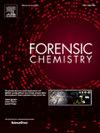Evaluation of the incorporation of µ-XRF SDD systems in analytical workflows of black electrical tapes
IF 2.6
3区 医学
Q2 CHEMISTRY, ANALYTICAL
引用次数: 0
Abstract
Micro-X-ray Fluorescence Spectrometry (µ-XRF) is a technique widely adopted in forensic laboratories that has recently experienced a significant improvement with silicon drift detectors (SDDs). However, the research lag in this area has not caught up with the emergent instrumental modernization. This study expands the current body of knowledge by addressing this gap and evaluating the optimal workflow to incorporate µ-XRF SDD methods in electrical tape examinations. The experimental design evaluates sample handling and chemical data interpretation when the tape needs to undergo latent fingerprint development. The dataset includes contemporary electrical tape from 45 rolls produced in four countries, seven manufacturers, ten brands, and various quality grades (high, medium, low); ten sections are sampled per roll. Pairwise comparisons (990) evaluate between-source discrimination and false inclusions. Also, the set contains five same-source rolls with 20 sections per roll to evaluate within-source variability and false exclusions (950 pairwise comparisons). Samples are examined by µ-XRF SDDs and three other conventional methods. Performance rates are reported for each technique alone and when used together to evaluate optimal combinations and analytical sequences. Due to high discrimination and classification abilities, it is recommended that µ-XRF analysis moves to the forefront of the analytical scheme after microscopic examination to optimize turnaround times, costs, and resources. Also, the study utilizes elemental ratio comparison intervals and quantitative similarity metrics that offer complementary information to reduce subjectivity in XRF spectral comparisons. The findings of this study are anticipated to assist forensic laboratories with improved protocols.

在黑色电气胶带的分析工作流程中纳入μ -XRF SDD系统的评估
微x射线荧光光谱法(µ-XRF)是法医实验室广泛采用的一种技术,最近硅漂移检测器(sdd)得到了显著改进。然而,这一领域的研究滞后并没有跟上仪器现代化的发展。本研究通过解决这一差距并评估将μ -XRF SDD方法纳入电气胶带检查的最佳工作流程,扩展了当前的知识体系。实验设计评估了样品处理和化学数据解释时,磁带需要进行潜在指纹显影。该数据集包括来自四个国家,七个制造商,十个品牌和各种质量等级(高,中,低)生产的45卷现代电气胶带;每卷抽样10段。两两比较(990)评估源间歧视和错误包含。此外,该集合包含五个相同来源的卷,每个卷有20个部分,以评估源内变异性和错误排除(950成对比较)。样品通过微xrf sds和其他三种常规方法进行检测。单独报告每种技术的性能率,并在一起使用时评估最佳组合和分析序列。由于高分辨和分类能力,建议在显微镜检查后将µ-XRF分析移到分析方案的前沿,以优化周转时间,成本和资源。此外,该研究利用元素比比较间隔和定量相似性指标,提供补充信息,以减少XRF光谱比较中的主观性。预计这项研究的结果将协助法医实验室改进协议。
本文章由计算机程序翻译,如有差异,请以英文原文为准。
求助全文
约1分钟内获得全文
求助全文
来源期刊

Forensic Chemistry
CHEMISTRY, ANALYTICAL-
CiteScore
5.70
自引率
14.80%
发文量
65
审稿时长
46 days
期刊介绍:
Forensic Chemistry publishes high quality manuscripts focusing on the theory, research and application of any chemical science to forensic analysis. The scope of the journal includes fundamental advancements that result in a better understanding of the evidentiary significance derived from the physical and chemical analysis of materials. The scope of Forensic Chemistry will also include the application and or development of any molecular and atomic spectrochemical technique, electrochemical techniques, sensors, surface characterization techniques, mass spectrometry, nuclear magnetic resonance, chemometrics and statistics, and separation sciences (e.g. chromatography) that provide insight into the forensic analysis of materials. Evidential topics of interest to the journal include, but are not limited to, fingerprint analysis, drug analysis, ignitable liquid residue analysis, explosives detection and analysis, the characterization and comparison of trace evidence (glass, fibers, paints and polymers, tapes, soils and other materials), ink and paper analysis, gunshot residue analysis, synthetic pathways for drugs, toxicology and the analysis and chemistry associated with the components of fingermarks. The journal is particularly interested in receiving manuscripts that report advances in the forensic interpretation of chemical evidence. Technology Readiness Level: When submitting an article to Forensic Chemistry, all authors will be asked to self-assign a Technology Readiness Level (TRL) to their article. The purpose of the TRL system is to help readers understand the level of maturity of an idea or method, to help track the evolution of readiness of a given technique or method, and to help filter published articles by the expected ease of implementation in an operation setting within a crime lab.
 求助内容:
求助内容: 应助结果提醒方式:
应助结果提醒方式:


